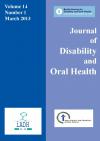Journal of Disability and Oral Health

- Cover Date:
- March 2013
- Print ISSN:
- 1470-8558
- Vol:
- 14
- Issue:
- 1
Editorial
Obesity Obesity is an escalating global health problem. It is defined in terms of “abnormal or excessive fat accumulation that may impair health†(World Health Organisation, 2012). This condition is preventable and yet over 2.8 million deaths worldwide each year are directly attributable to being overweight and obese. Whilst previously considered a problem for high-income countries, there is now evidence that obesity is increasing in low and middle income countries, adding to the burden of disease and widening health inequalities. The 20011/12 Health Survey for England (Joint Health Surveys Unit NatCen Social Research Department of Epidemiology and Public Health UCL (University College London), 2012) found that a quarter of all adults were obese and 60% were overweight. In children, the 2011/12 National Childhood Measurement Programme (The Health and Social Care Information Centre Lifestyles Statistics, 2012) also found that 19% of 10-11 year olds in England were obese and 34% were overweight. Obesity levels amongst the least affluent children are twice that of the most affluent and the inequality gap is widening (Ridler et al., 2013). The impact upon health services is considerable, obesity related problems are estimated to cost £5 billion per year and these costs are expected to double over the next 40 years (The Royal College of Physicians, 2013). A concern for the dental profession is how to address the dental needs of an increasing number of overweight and obese patients (Levine, 2012). Obesity is a major risk factor for a range of health problems such as diabetes, cardiovascular disease and some cancers (Reilly et al., 2009). As a consequence of these conditions, providing dental care for these patients can be a challenge. As the population of these patients increases, shaping care to meet these challenges will require a robust evidence base underpinned by research for clinical practice, training, equipment, workforce, infrastructure, communications and logistics. Many patients with severe and complex obesity cannot be treated in a standard dental chair and the costs of providing a suitable surgery and transport for these patients can be considerable. As funding for health is scarce, strategic planning and joined up working will be needed to ensure bariatric dental services are available at strategic locations. To be effective, these services will need a supporting infrastructure to transport patients to facilities, protocols for patient management, and pathways for care. Despite the difficulties, these challenges may provide opportunities, for example the chance to develop centres of expertise for bariatric dental care. With the rising problem of obesity, dental professionals will need to reflect upon their roles and responsibilities in relation to the prevention of this disease on a global, national and local level.
- Article Price
- £15.00
- Institution Article Price
- £
- Page Start
- 3
- Page End
- 4
- Authors
- Ilona Johnson
Articles from this issue
- Title
- Pg. Start
- Pg. End
- A critical appraisal of the literature on Palatal Plate Therapy for orofacial dysfunction in patients with Down syndrome
- 5
- 14
- The use of orofacial regulation therapy, including Palatal Plate Therapy, in the management of orofacial dysfunction in patients with Down syndrome
- 15
- 24
- A case of tooth wear and self-reported local anaesthetic insensitivity in a patient with Ehlers-Danlos Syndrome
- 25
- 28
